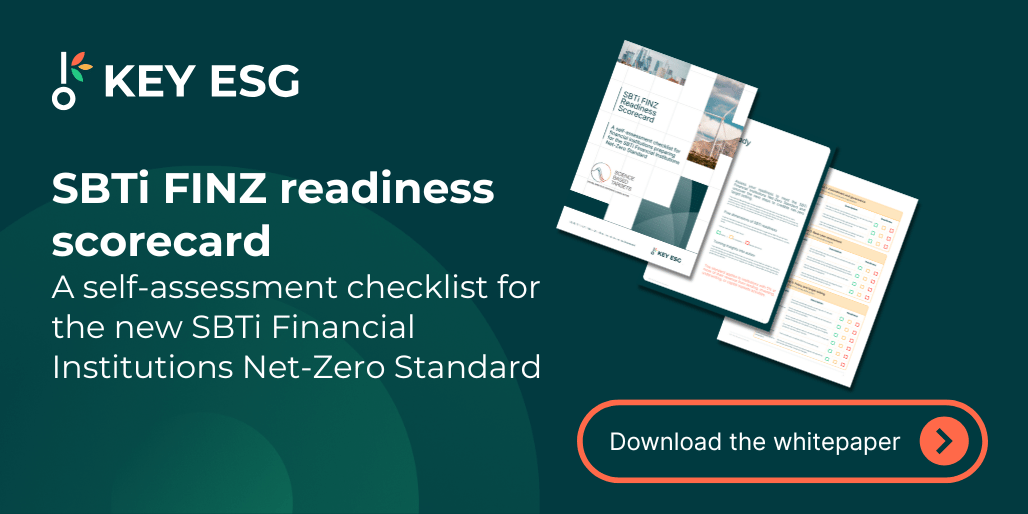The what, why and how of the SBTi
The Science Based Targets initiative (SBTi) was launched in 2015 to help businesses to reduce their carbon emissions, adhere to regulatory guidance, and mitigate the effects of climate change.
The initiative was part of a collaboration between the Carbon Disclosure Project (CDP), the United Nations Global Compact, World Resources Institute (WRI), and the World Wide Fund for Nature (WWF). It aims to drive measurable climate action in the private sector by enabling companies to set science-based emissions reduction targets.
Why is the SBTi important?
The SBTi aligns with the Paris Agreement
One of the key aspects of SBTi is its alignment with the Paris Agreement. The Paris Agreement is a legally binding international treaty on climate change that was signed by 196 Parties at the UN Climate Change Conference (COP21) in 2015.
All signatories agreed to set targets aligned with the need to limit global warming to well below 2°C above pre-industrial levels, with an ambition to cap it at 1.5°C. By adhering to these targets, companies contribute significantly to global efforts against climate change.
The SBTi upholds this agreement and holds companies accountable.
The SBTi plays a key role in corporate sustainability
The SBTi serves as a blueprint for corporations aiming to transition towards more sustainable operational models. Investors, customers, and employees are increasingly prioritising environmental responsibility, and so adhering to SBTi guidance not only improves sustainability in the long-run, but it also makes a firm more attractive to a variety of different stakeholders.
The SBTi prevents greenwashing
Although the SBTi has been around for a long time, it has become increasingly important in recent years. More and more firms are seeking external validation for their sustainability endeavours in an attempt to tackle issues with greenwashing.
SBTi certification acts as a stamp of approval that stakeholders can trust.
Implementing SBTi in business strategy
Setting Science-Based Targets
For a company to set science-based targets through the SBTi, it must first undergo a rigorous process that involves comprehensive emissions assessments and long-term strategy planning. This process ensures that the targets that the firm sets are not only ambitious, but also attainable and relevant to the company's specific industry and context.
Scope 1, 2, and 3 emissions are assessed for the last 3 years of the company’s operation, and the averages are used to calculate how the firm can improve and eventually reach Net Zero.
Establishing a certified SBTi pathway
Once all of the relevant data has been analysed in detail, an SBTi pathway can be established.
Several methods can be used to set out a pathway, but the Sectoral Decarbonization Approach (SDA) is one of the most commonly used. Developed by the partners of the SBTi, with technical support from Ecofys, the SDA model enables firms to set reduction targets based on the International Energy Agency’s (IEA) detailed CO2 sector scenario.
This pathway can then be officially validated by the SBTi. The application guidelines for submitting a pathway to the SBTi can be found here.
Tracking progress
Once a pathway has been SBTi certified, the company in question must continue to report on its emissions and disclose the progress made. This transparency keeps the firm accountable to its stakeholders.
To increase the likelihood of sticking to their approved SBTi pathway, many private sector companies opt to use software, such as KEY ESG’s Carbon Accounting Platform, to help them monitor progress and stay on track.
The benefits of adopting SBTi
Adopting SBTi can offer numerous benefits to businesses and funds:
- SBTi validation enhances corporate reputation, as it demonstrates a commitment to sustainable practices.
- Committing to the SBTi helps companies to future-proof their operations against regulatory changes and to tap into new markets and investment opportunities focused on sustainability.
- The SBTi is aligned with the latest Environmental, Social, and Governance (ESG) regulations, so voluntary compliance in this regard often aligns with regulatory compliance.
The SBTi is not just another set of eco-friendly guidelines. It represents a shift in how businesses view their role in society and the environment. Those who pursue SBTi pathway certification stand out as leaders in their field, truly committed to improving their sustainability.
As the world gravitates towards more sustainable practices, the SBTi will continue to become increasingly prominent, guiding companies on their journey to a greener, more responsible future.
How KEY ESG can help
Making the commitment to a SBTi pathway is the first step. But following the pathway and communicating progress is really where the hard work begins. Fortunately, KEY ESG’s Carbon Accounting Platform reduces the complexity of Scope 1, 2 and 3 carbon accounting and automates much of the process.
KEY ESG’s intuitive software can integrate SBTi approved pathways to help firms track progress according to their validated path. This improves accountability, provides clear guidance on how to make improvements, and makes stakeholder communications easy through clear visuals.
Request a demo or contact a member of the KEY ESG team today to discuss how we can help your firm to not only achieve SBTi certification, but to attain success in your green initiatives, improve operational sustainability, and reach your ESG targets.
The what, why and how of the SBTi
The Science Based Targets initiative (SBTi) was launched in 2015 to help businesses to reduce their carbon emissions, adhere to regulatory guidance, and mitigate the effects of climate change.
The initiative was part of a collaboration between the Carbon Disclosure Project (CDP), the United Nations Global Compact, World Resources Institute (WRI), and the World Wide Fund for Nature (WWF). It aims to drive measurable climate action in the private sector by enabling companies to set science-based emissions reduction targets.
Why is the SBTi important?
The SBTi aligns with the Paris Agreement
One of the key aspects of SBTi is its alignment with the Paris Agreement. The Paris Agreement is a legally binding international treaty on climate change that was signed by 196 Parties at the UN Climate Change Conference (COP21) in 2015.
All signatories agreed to set targets aligned with the need to limit global warming to well below 2°C above pre-industrial levels, with an ambition to cap it at 1.5°C. By adhering to these targets, companies contribute significantly to global efforts against climate change.
The SBTi upholds this agreement and holds companies accountable.
The SBTi plays a key role in corporate sustainability
The SBTi serves as a blueprint for corporations aiming to transition towards more sustainable operational models. Investors, customers, and employees are increasingly prioritising environmental responsibility, and so adhering to SBTi guidance not only improves sustainability in the long-run, but it also makes a firm more attractive to a variety of different stakeholders.
The SBTi prevents greenwashing
Although the SBTi has been around for a long time, it has become increasingly important in recent years. More and more firms are seeking external validation for their sustainability endeavours in an attempt to tackle issues with greenwashing.
SBTi certification acts as a stamp of approval that stakeholders can trust.
Implementing SBTi in business strategy
Setting Science-Based Targets
For a company to set science-based targets through the SBTi, it must first undergo a rigorous process that involves comprehensive emissions assessments and long-term strategy planning. This process ensures that the targets that the firm sets are not only ambitious, but also attainable and relevant to the company's specific industry and context.
Scope 1, 2, and 3 emissions are assessed for the last 3 years of the company’s operation, and the averages are used to calculate how the firm can improve and eventually reach Net Zero.
Establishing a certified SBTi pathway
Once all of the relevant data has been analysed in detail, an SBTi pathway can be established.
Several methods can be used to set out a pathway, but the Sectoral Decarbonization Approach (SDA) is one of the most commonly used. Developed by the partners of the SBTi, with technical support from Ecofys, the SDA model enables firms to set reduction targets based on the International Energy Agency’s (IEA) detailed CO2 sector scenario.
This pathway can then be officially validated by the SBTi. The application guidelines for submitting a pathway to the SBTi can be found here.
Tracking progress
Once a pathway has been SBTi certified, the company in question must continue to report on its emissions and disclose the progress made. This transparency keeps the firm accountable to its stakeholders.
To increase the likelihood of sticking to their approved SBTi pathway, many private sector companies opt to use software, such as KEY ESG’s Carbon Accounting Platform, to help them monitor progress and stay on track.
The benefits of adopting SBTi
Adopting SBTi can offer numerous benefits to businesses and funds:
- SBTi validation enhances corporate reputation, as it demonstrates a commitment to sustainable practices.
- Committing to the SBTi helps companies to future-proof their operations against regulatory changes and to tap into new markets and investment opportunities focused on sustainability.
- The SBTi is aligned with the latest Environmental, Social, and Governance (ESG) regulations, so voluntary compliance in this regard often aligns with regulatory compliance.
The SBTi is not just another set of eco-friendly guidelines. It represents a shift in how businesses view their role in society and the environment. Those who pursue SBTi pathway certification stand out as leaders in their field, truly committed to improving their sustainability.
As the world gravitates towards more sustainable practices, the SBTi will continue to become increasingly prominent, guiding companies on their journey to a greener, more responsible future.
How KEY ESG can help
Making the commitment to a SBTi pathway is the first step. But following the pathway and communicating progress is really where the hard work begins. Fortunately, KEY ESG’s Carbon Accounting Platform reduces the complexity of Scope 1, 2 and 3 carbon accounting and automates much of the process.
KEY ESG’s intuitive software can integrate SBTi approved pathways to help firms track progress according to their validated path. This improves accountability, provides clear guidance on how to make improvements, and makes stakeholder communications easy through clear visuals.
Request a demo or contact a member of the KEY ESG team today to discuss how we can help your firm to not only achieve SBTi certification, but to attain success in your green initiatives, improve operational sustainability, and reach your ESG targets.





.avif)
